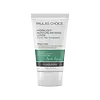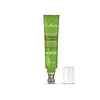What's inside
What's inside
 Key Ingredients
Key Ingredients

 Benefits
Benefits

 Concerns
Concerns

 Ingredients Side-by-side
Ingredients Side-by-side

Water
Skin ConditioningNeopentyl Glycol Diheptanoate
EmollientCyclopentasiloxane
EmollientButylene Glycol
HumectantDimethicone
EmollientBis-Diglyceryl Polyacyladipate-2
EmollientPropylene Glycol Isoceteth-3 Acetate
Skin ConditioningSqualane
EmollientGlyceryl Stearate
EmollientPEG-100 Stearate
Potassium Cetyl Phosphate
EmulsifyingCetyl Alcohol
EmollientMagnesium Aluminum Silicate
AbsorbentTocopheryl Acetate
AntioxidantCholesterol
EmollientAvena Sativa Kernel Extract
AbrasiveCamellia Sinensis Leaf Extract
AntimicrobialPunica Granatum Extract
AstringentVaccinium Macrocarpon Fruit Extract
AstringentSodium Hyaluronate
HumectantGlycerin
HumectantSuperoxide Dismutase
AntioxidantTetrahexyldecyl Ascorbate
AntioxidantSodium PCA
HumectantPhytosphingosine
Skin ConditioningCaprylic/Capric Triglyceride
MaskingDimethicone Crosspolymer
Emulsion StabilisingCucumis Sativus Fruit Extract
EmollientXanthan Gum
EmulsifyingLaureth-4
EmulsifyingLaureth-23
CleansingSodium Hydroxide
BufferingPhenoxyethanol
PreservativeChlorphenesin
AntimicrobialBenzoic Acid
MaskingSorbic Acid
PreservativeWater, Neopentyl Glycol Diheptanoate, Cyclopentasiloxane, Butylene Glycol, Dimethicone, Bis-Diglyceryl Polyacyladipate-2, Propylene Glycol Isoceteth-3 Acetate, Squalane, Glyceryl Stearate, PEG-100 Stearate, Potassium Cetyl Phosphate, Cetyl Alcohol, Magnesium Aluminum Silicate, Tocopheryl Acetate, Cholesterol, Avena Sativa Kernel Extract, Camellia Sinensis Leaf Extract, Punica Granatum Extract, Vaccinium Macrocarpon Fruit Extract, Sodium Hyaluronate, Glycerin, Superoxide Dismutase, Tetrahexyldecyl Ascorbate, Sodium PCA, Phytosphingosine, Caprylic/Capric Triglyceride, Dimethicone Crosspolymer, Cucumis Sativus Fruit Extract, Xanthan Gum, Laureth-4, Laureth-23, Sodium Hydroxide, Phenoxyethanol, Chlorphenesin, Benzoic Acid, Sorbic Acid
Water
Skin ConditioningCaprylic/Capric Triglyceride
MaskingStearyl Alcohol
EmollientButyrospermum Parkii Butter
Skin ConditioningGlyceryl Stearate
EmollientCetyl Alcohol
EmollientGlyceryl Stearate Citrate
EmollientCetearyl Alcohol
EmollientRicinus Communis Seed Oil
MaskingRosa Canina Fruit Oil
EmollientCamellia Sinensis Leaf Powder
ExfoliatingYogurt Extract
Skin ConditioningSilybum Marianum Seed Extract
Skin ConditioningLactobacillus/Leuconostoc/Acetobacter/Kluyveromyces/Saccharomyces Milk Ferment Filtrate
HumectantInulin
Skin ConditioningAcacia Senegal Gum
MaskingNiacinamide
SmoothingMelia Azadirachta Leaf Extract
Skin ConditioningMelia Azadirachta Flower Extract
Skin ConditioningCorallina Officinalis Extract
Skin ConditioningAmber Powder
Coccinia Indica Fruit Extract
Skin ConditioningSolanum Melongena Fruit Extract
Skin ConditioningOcimum Sanctum Leaf Extract
Skin ConditioningCurcuma Longa Leaf Extract
Skin ConditioningMoringa Oleifera Seed Oil
EmollientHydrogenated Castor Oil
EmollientCopernicia Cerifera Wax
Panthenol
Skin ConditioningAllantoin
Skin ConditioningGlycerin
HumectantBenzoic Acid
MaskingTriethyl Citrate
MaskingGlyceryl Caprylate
EmollientCaprylyl Glycol
EmollientWater, Caprylic/Capric Triglyceride, Stearyl Alcohol, Butyrospermum Parkii Butter, Glyceryl Stearate, Cetyl Alcohol, Glyceryl Stearate Citrate, Cetearyl Alcohol, Ricinus Communis Seed Oil, Rosa Canina Fruit Oil, Camellia Sinensis Leaf Powder, Yogurt Extract, Silybum Marianum Seed Extract, Lactobacillus/Leuconostoc/Acetobacter/Kluyveromyces/Saccharomyces Milk Ferment Filtrate, Inulin, Acacia Senegal Gum, Niacinamide, Melia Azadirachta Leaf Extract, Melia Azadirachta Flower Extract, Corallina Officinalis Extract, Amber Powder, Coccinia Indica Fruit Extract, Solanum Melongena Fruit Extract, Ocimum Sanctum Leaf Extract, Curcuma Longa Leaf Extract, Moringa Oleifera Seed Oil, Hydrogenated Castor Oil, Copernicia Cerifera Wax, Panthenol, Allantoin, Glycerin, Benzoic Acid, Triethyl Citrate, Glyceryl Caprylate, Caprylyl Glycol
Ingredients Explained
These ingredients are found in both products.
Ingredients higher up in an ingredient list are typically present in a larger amount.
Benzoic Acid is used to preserve and adjust the pH of products.
The antimicrobial property of Benzoic Acid helps elongate a product's shelf life. Its main role is to reduce fungi growth and is not found to be effective at fighting bacteria. Therefore Benzoic Acid is always added along with other preservatives.
In its pure form, Benzoic Acid looks like a white crystalline solid. It has slight solubility in water.
The name of Benzoic Acid comes from gum benzoin, which used to be the sole source of deriving this ingredient. Benzoic Acid is the most simple aromatic carboxylic acid.
Benzoic Acid is naturally occuring in strawberries, mustard, cinnamon, and cloves. It has a slight scent but is not considered to be a fragrance.
Learn more about Benzoic AcidThis ingredient is an emollient, solvent, and texture enhancer. It is considered a skin-softener by helping the skin prevent moisture loss.
It helps thicken a product's formula and makes it easier to spread by dissolving clumping compounds.
Caprylic Triglyceride is made by combining glycerin with coconut oil, forming a clear liquid.
While there is an assumption Caprylic Triglyceride can clog pores due to it being derived from coconut oil, there is no research supporting this.
Learn more about Caprylic/Capric TriglycerideCetyl Alcohol is a fatty alcohol. Fatty Alcohols are most often used as an emollient or to thicken a product.
Its main roles are:
Though it has "alcohol" in the name, it is not related to denatured alcohol or ethyl alcohol.
The FDA allows products labeled "alcohol-free" to have fatty alcohols.
Learn more about Cetyl AlcoholGlycerin is already naturally found in your skin. It helps moisturize and protect your skin.
A study from 2016 found glycerin to be more effective as a humectant than AHAs and hyaluronic acid.
As a humectant, it helps the skin stay hydrated by pulling moisture to your skin. The low molecular weight of glycerin allows it to pull moisture into the deeper layers of your skin.
Hydrated skin improves your skin barrier; Your skin barrier helps protect against irritants and bacteria.
Glycerin has also been found to have antimicrobial and antiviral properties. Due to these properties, glycerin is often used in wound and burn treatments.
In cosmetics, glycerin is usually derived from plants such as soybean or palm. However, it can also be sourced from animals, such as tallow or animal fat.
This ingredient is organic, colorless, odorless, and non-toxic.
Glycerin is the name for this ingredient in American English. British English uses Glycerol/Glycerine.
Learn more about GlycerinGlyceryl Stearate is a mix of glycerin and stearic acid.
It is used to stabilize the mixing of water and oil ingredients. By preventing these ingredients from separating, it can help elongate shelf life. It can also help thicken the product's texture.
As an emollient, it helps soften skin and supports barrier-replenishing ingredients.
In cosmetics, Glyceryl Stearate is often made from vegetable oils or synthetically produced.
This ingredient may not be fungal-acne safe
Fun fact: The human body also creates Glyceryl Stearate naturally.
Learn more about Glyceryl StearateWater. It's the most common cosmetic ingredient of all. You'll usually see it at the top of ingredient lists, meaning that it makes up the largest part of the product.
So why is it so popular? Water most often acts as a solvent - this means that it helps dissolve other ingredients into the formulation.
You'll also recognize water as that liquid we all need to stay alive. If you see this, drink a glass of water. Stay hydrated!
Learn more about Water